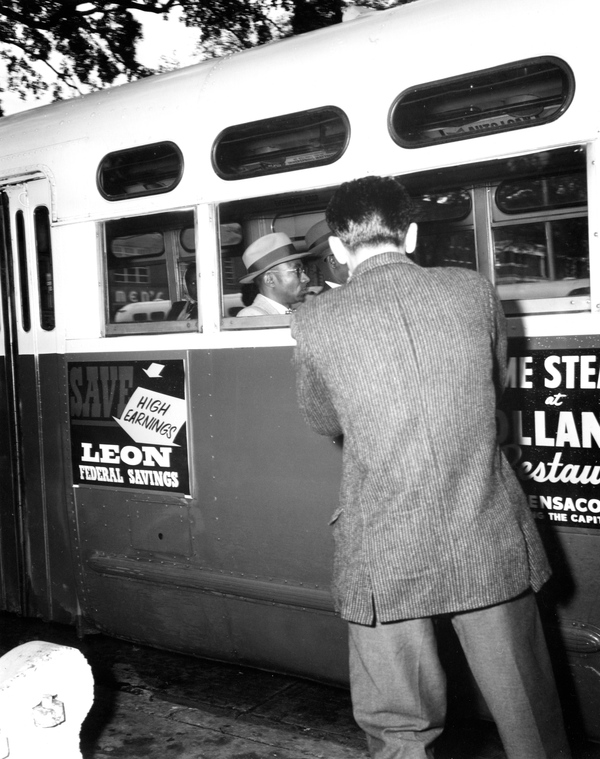The Civil Rights Movement in Florida
Lesson Plans
Photo Analysis: Civil Rights Leaders Defying Segregated Bus Seating
4th Grade Lesson Plan

Download: small jpg | large jpg
Overview
On December 1, 1955, Rosa Parks refused to give up her seat to a white passenger, sparking the Montgomery bus boycott in Alabama. Five months later, in Tallahassee, two female students from Florida A&M University (FAMU) sat down in the “whites only” section of a segregated bus. When they refused to move to the “colored” section at the rear of the bus, the driver pulled into a service station and called the police. In response, FAMU students organized a boycott of Tallahassee city buses.
Reverend C.K. Steele formed the Inter-Civic Council to manage the logistics behind the city-wide boycott. For nearly seven months in 1956, African-Americans in Tallahassee would not ride the city buses in protest of the segregated seating. The boycott had an immediate impact on bus fare revenues. As a result of the boycott, 21 members of the Inter-Civic Council were convicted on charges of operating an illegal transportation system set up as a car pool without a franchise. They were fined $11,000.
When the U.S. Supreme Court ruled in November 1956 that Alabama's segregated busing laws were unconstitutional, Tallahassee civil rights leaders put pressure on Florida Governor LeRoy Collins to desegregate city buses. On December 24, Reverend C.K. Steele, Reverend A.C. Redd and Reverend H. McNeal Harris rode several buses sitting close to the front. Reverend J. Meta Rollins and Reverend Dan B. Speed also defied the seating convention on several buses that day. On December 27, 1956, a planned front riding bus demonstration was called off when a group of about 200 whites gathered near the Park Avenue/Monroe Street bus transfer point.
Governor Collins suspended bus service in Tallahassee on January 1, 1957. On January 7, Tallahassee repealed the segregated seating ordinance. Through nonviolent protest, the Tallahassee bus boycott succeeded. It set a precedent for the state as, city by city, public transportation was desegregated in Florida.
Guiding Questions
- What was the role of Florida in the civil rights movement?
- What was the importance of the Tallahassee bus boycott in the civil rights movement?
- What were the nonviolent tactics used by activists during the civil rights movement?
Objectives
Students will:
- Analyze a photograph taken during the Tallahassee bus boycott.
- Write about history using primary sources.
Grade
4
Florida Standards
SS.4.A.1.1: Analyze primary and secondary resources to identify significant individuals and events throughout Florida history.
Examples may include, but are not limited to, photographs, paintings, maps, artifacts, timelines, audio and video, letters and diaries, periodicals, newspaper articles, etc.
SS.4.A.8.1: Identify Florida’s role in the Civil Rights Movement.
Examples may include, but are not limited to, Tallahassee Bus Boycotts, civil disobedience, and the legacy of early civil rights pioneers, Harry T. and Harriette V. Moore.
Materials Needed
- Photo analysis worksheet from the National Archives and Records Administration.
- Photograph of Reverend C.K. Steele and Reverend H. McNeal Harris protesting segregated bus seating in Tallahassee.
Procedure
Introducing Content
- Review previously covered material dealing with the civil rights movement in Florida, segregation, civil disobedience and the Tallahassee bus boycott.
-
Conduct an in-class discussion/survey of students’ prior knowledge of civil disobedience in response to segregation.
- What do students know about Rosa Parks and the Montgomery bus boycott?
- How do students think African-American men and women in other cities reacted to segregation on public buses after Rosa Parks began the protest in Montgomery?
- Give students brief background information about the Tallahassee bus boycott.
Photo Analysis
- Students will analyze the photograph of Reverend C.K. Steele and Reverend H. McNeal Harris protesting segregated bus seating in Tallahassee.
- Students will record their reactions to the photograph using the photo analysis worksheet.
- The teacher will conduct an in-class discussion/survey of what students learned during the photo analysis. What can students infer from the photograph about the emotions of people involved in the protest? Were they surprised by anything they saw?
- Teachers may take time to answer any questions students have after their examination of the photograph.
Sample student question: Students may wonder why protestors are riding the bus in this photograph (instead of boycotting the bus).
Sample teacher explanation: For nearly seven months in 1956, African-American men and women in Tallahassee would not ride the city buses in protest of the segregated seating. This photograph was taken shortly after the U.S. Supreme Court ruled that Alabama's segregated busing laws were unconstitutional. Leaders of the Tallahassee bus boycott then organized "front riding bus demonstrations" to challenge the segregation of Tallahassee buses.
Writing About the Tallahassee Bus Boycott
Students will write brief journal responses to the photograph, focused on what they learned about the Tallahassee bus boycott.
Extension Activity
SS.4.A.1.2: Synthesize information related to Florida history through print and electronic media.
This exchange between the Inter-Civic Council of Tallahassee and Governor LeRoy Collins presents two different views of the Tallahassee bus boycott. For further study, have students read the telegrams and the letter. Then have students compare the language used to describe the events and facts that are included or omitted in each account.
- Telegram to Governor LeRoy Collins from the Inter-Civic Council of Tallahassee, September 27, 1956.
- Telegram to Governor LeRoy Collins from C.K. Steele, September 28, 1956.
- Reply to C.K. Steele from Governor LeRoy Collins, September 28, 1956.

 Listen: The Latin Program
Listen: The Latin Program